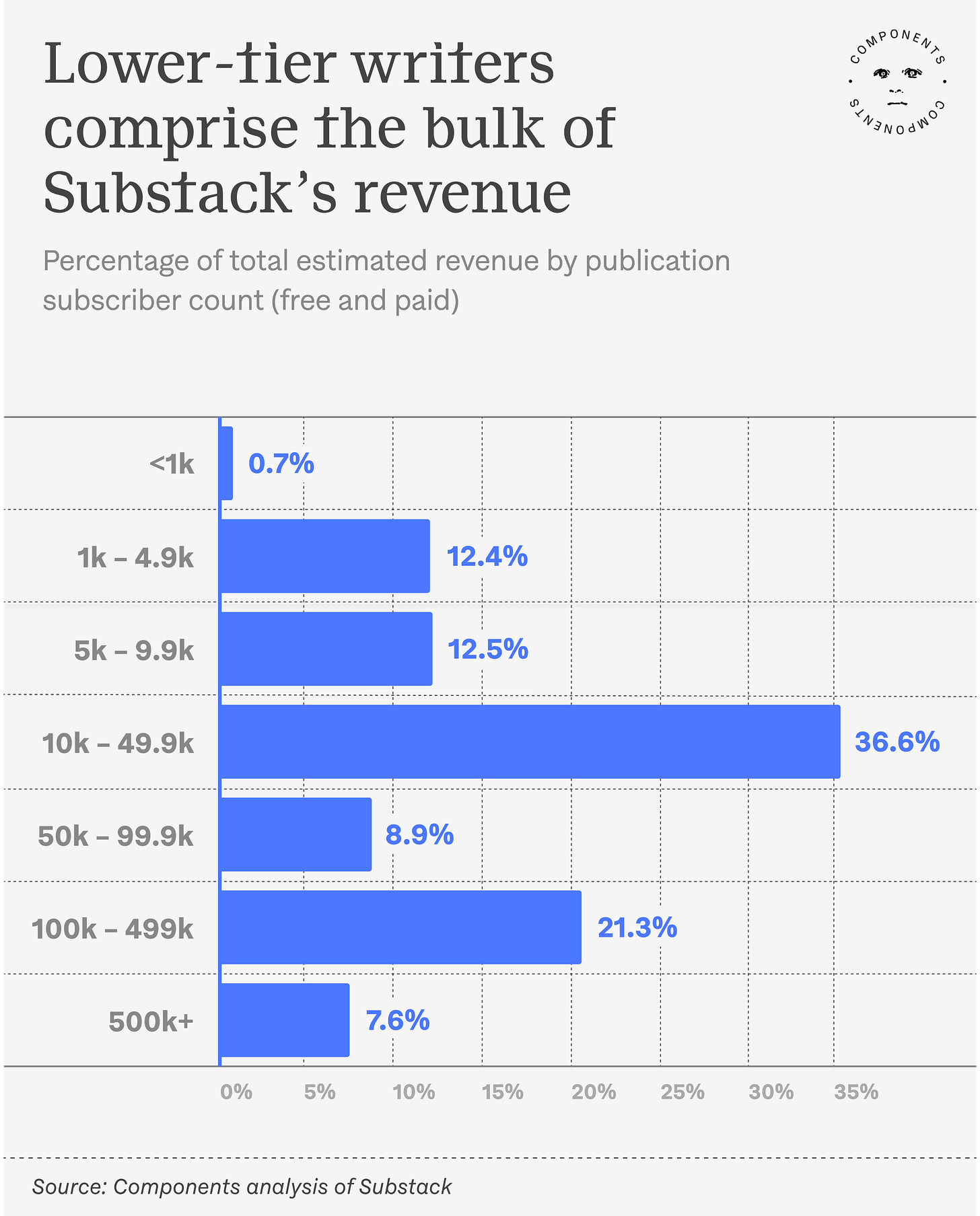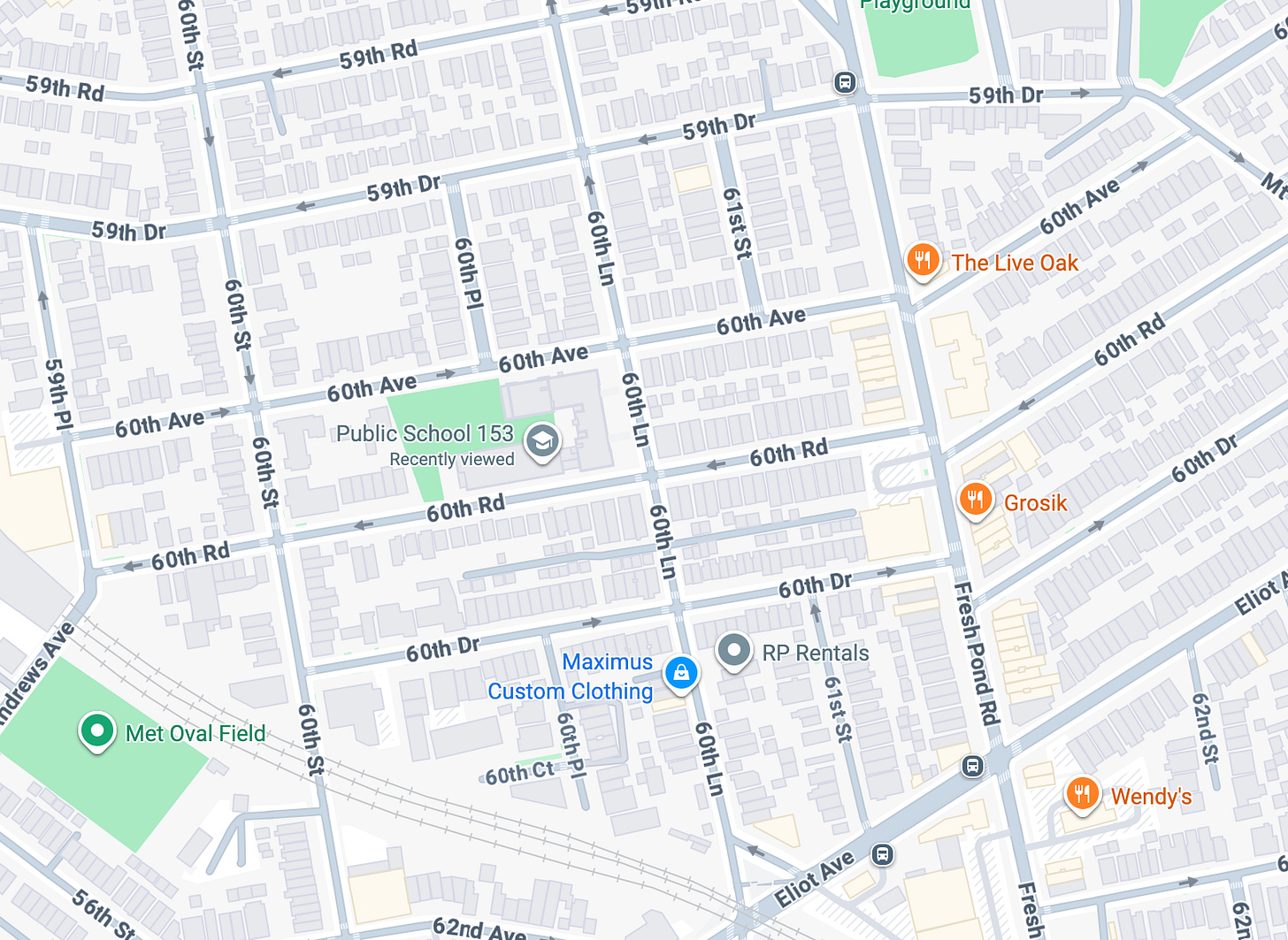Sunday Edition #21 - Dissecting Substack’s Inverted Revenue Curve
Also: The Streets of Queens, One Battle After Another, and Night Tapes (again)
Substack’s Inverted Revenue Curve
This article definitely challenged my intuition of modern platform economics (ht Mat). We’re used now to the reality that on most digital platforms these days that there’s a strong power curve. A small percentage of creators on a platform earn the most of the revenue. We’re used to examples like: “On Spotify, 90% of streams go to the top 1% of artists.” The article’s premise is, is that this is prevalent on platforms where revenue is secondary to the actual transaction. In other words, we watch YouTube for free and the creators earn from ads YouTube displays on their videos.
Substack’s revenue curve looks different. The bulk of the revenue does *not* go towards the most popular creators which fulfills the old narrative of the “long tail”.
The argument is, is that Substack *as a platform* works differently. It’s not selling attention, but simply, access. It’s a more directed exchange of value compared to the ad revenue tango. I subscribe. I read your writing.
These needs and desires follow the contours of groups and individuals and their own positions in the world in a way the universal dynamics of attention can’t. A private equity analyst needs information that a nurse doesn’t. A gamer wants to play Ghostwire: Tokyo, a quilter wants to make a quilt, a NASCAR driver cares about tires and stuff, and to you, your lover is the most beautiful person in the world. Attention has few optima, desire has many.
So, yes, the argument makes sense. Adding money into our information mix again, there’s more cost at stake and thus it expresses individual desire in the marketplace again compared to amorphous “ad groups”. And, I believe one of the key components of this individual desire is to simply support what you like. It’s a similar sentiment to when, you say, discover a new band and love their music. They happen to come through your city, so you go and watch them in a small venue, and then decide to buy the merch to support them. You wouldn’t otherwise have bought the merch, but it’s about being given the opportunity to support something you like when it’s *there*. I subscribe to various Substacks, both purely for the content, but also to support smaller writers who are doing interesting work. Ad attention economics discounts these smaller writers because they can’t figure out who the viewers are.
So, when real money is exchanged in an information marketplace, people do discount supporting larger and more successful creators because it’s a calculus of: “I’d rather my money go towards my friend’s attempt at becoming a writer than supporting a writer who doesn’t need my extra few bucks a month.” Supporting the latter would simply come from only wanting to read paywalled articles, not from some other incentive.
That being said. If this thesis holds true, why Substack, and why now? The web platform era has many examples of users and creators exchanging money between them without resorting to ad economics. Does Patreon have similar curves, for example? Or, OnlyFans?! I tried finding numbers, but couldn’t find convincing evidence otherwise. Maybe there is more information that proves this point. Or what about more traditional creative industries, like the art world? The music industry has been warped by the DSPs (Spotify) irrevocably, but the art world has no “digital attention economics”? Or, could one say that the art world’s power law distribution curves (where few artists make mega bucks) is simply downstream from attention economics of Instagram? Literature, to some extent, can these days be seen as downstream from attention economics of BookTok?
It’s perhaps, that Substack’s unique curve relies on it being a medium that has no strong ad attention economics upstream of it because consuming essays simply take a lot of time and continuous consumption. That being said, attention economics isn’t unavoidable. There has been a sense the Notes inside Substack is incentivizing the sharing of viral content that seem to fit a Substack-ian mold of some variation of grand-theory-of-everything articles alongside lowercase-insight-porn.
Either way. It’s interesting. At the end of the day, I think it holds true that removing ad intermediaries gets us closer to a flatter distribution curve, but I think something else is going on inside Substack that accounts for its different revenue curve.
I’m not entirely convinced that simply adding direct exchange of value changes the dynamic. I think there’s ultimately more going on here. Curious if anyone has any thoughts to share.
The Quirks of Queens
I found this unique section in Queens recently.
Looks very confusing. It’s not unique to this bundle of 60th everything. Queens in general have strange assignments of roads.
I went looking for answers as to why they did it this way. It came down to the fact that original grid layout were simply streets (north to south) and avenues (east to west).
In densification, when extra roads were added in-between, they simply followed a naming scheme to fit within the old grid system.
Ron Miller explains:
The Streets are laid out in an approximately linear fashion. They begin at 1st Street and increase numerically towards the eastern border. They currently go as high as 271st Street. When the blocks are small or are added after the initial layout and assignment, additional names appear. After Street would come Place followed, if required, by Lane. This is why only some numbers have the additional designation of Place or Lane. For example, if two streets were to be added between 21st Street and 22nd Street, the order would become 21st Street, 21st Place, 21st Lane and then 22nd Street.
Similarly, the Avenues go to the southern border and go as high as 167th Avenue. When the blocks are small or are added after the initial layout and assignment, additional names appear. These are assigned, in order, Road, Drive, then Terrace. This is why only some numbers have the additional designations of Road, Drive or Terrace. As an example, if three streets were to be added between 21st Avenue and 22nd Avenue, the sequence would become 21st Avenue, 21st Road, 21st Drive, 21st Terrace, and then 22nd Avenue.
Prediction
Loved this article from Sachin, which makes the premise that a part of the rise of gambling and prediction markets in general point to a societal need to feel like we are in control of our future in an age of confusing complexity.
Prediction has an overwhelming amount of cynical participation, and what Peter Sloterdijk once called “enlightened false consciousness”: the ability to see through ideology while still performing it. The wager becomes a parody of belief, a way to inhabit a future one no longer trusts by speculating on its image.
In that sense, Prediction is not the ontology of what comes next but a mourning for the modern ontology of the future as something predictable. Beneath the rhetoric of probabilistic rationality lies a desperate nostalgia for a time when the future could still be believed in.
Where to from here?
What I’m Up To
I turned 36 this week. I’ve never really been a stickler for complaining about growing older. Never been that bothered. But, given that I had a unique year in rebuilding my life after divorce, it’s admittedly the first birthday where I actually like life is passing me by too quickly. I think I will feel younger again when I turn 37 next year. ;)
✍️ Writing - Novel #2 Revisions
I had written off the initial batch of 8 agents I queried in July, having been rejected by some and not hearing back from others while I was busy doing revisions. But, just to give you context on the timelines of this process. An agent sent a rejection 3 months later this week. Sometimes, the process can just take quite long.
That being said, I believe I should be on target for finishing this revision in the next 2 weeks. I’m having fun with it as I’m over the toughest part of the revisions! :)
🕹️ Gaming - Hades 2
Still enjoying this a lot. And trying ignore trying Subway Builder as much as I can. 😅
📺 Watching - One Battle After Another
A really great film with stellar directing and performances. One thing I love the most about this film is that it’s a masterful showcase in how in sometimes with having simple elements, you can add so much depth and flair. The film is entirely serious on its surface, but the directing and acting adds extremely watchable humor throughout. It’s such a fine line to get right, because you can tell it is deliberate, while feeling so natural. Humor in film is often played up in a way where the director doesn’t always trust the audience (MCU humor can be the worst culprit here). Paul Thomas Anderson trusts the audience and I love that. I also enjoyed the goofy LARP-ing of extremist institutions, which given the humor of the film, is another reminder that extremist movements always demand to be taken seriously. They deflate when you laugh at them instead. This is for you if: you enjoy great action directing with dark humor.
🏃 Running (and Meditation)
Been pushing my trail long runs recently, going for 23km at a time over 3 hours and testing nutrition. Must admit, being in constant training mode since June has been getting to me. The last stretch is upon me and then looking forward to a well-deserved break. Since I’ve restarted daily meditation practice, I’ve also used my running as a meditative tool, listening to talks by teachers like Joseph Goldstein. It’s been great. Also, such a beautiful time of the year to run in nature on east coast USA. Making the final push easier. :)
🎶 Listening - Night Tapes
Went to see Night Tapes this week. They’ve been the backdrop of my year and I was so happy that they came through town. Besides my perpetual obsession with Casino Versus Japan they were my most listened to band this year. Magical live. So, here’s Drifting, again.
So damn dreamy.
That’s it for this week, folks! Hope you get to see a lovely sunset.
Simon






Hi Simon - thanks for these observant and fun pieces. I've been reading them for a while, often tempted to respond, and then distracted. LOL.
To your question as to why Substack seems to perform differently than other media platforms,
I'd recommend checking out Carvell Wallace's lament on the "collapse of thoughtful journalism" (https://open.substack.com/pub/carvellwallace/p/pure-ghost-radio-october-2025).
Perhaps there are fewer platforms available for places where "Writers help us frame reality, they help us understand it, they help us question it", and that hunger for this kind of media makes us more likely to support (pay) for access to writers and pieces that aren't just "viral".
Always inspiring to read your writing. I too have been processing a similar life transition. Not always easy but just want to let you know I see you. It’s all good and sorry to hear you had to part ways with someone you spent time with. I know the feels✌️ Cheers Simon. If you ever want to catch up, feel free to hit me up. Would love to chat with someone with similar world view again. The world has drifted quite a bit over the years and I find myself reaching out to the “OGs” more and more.